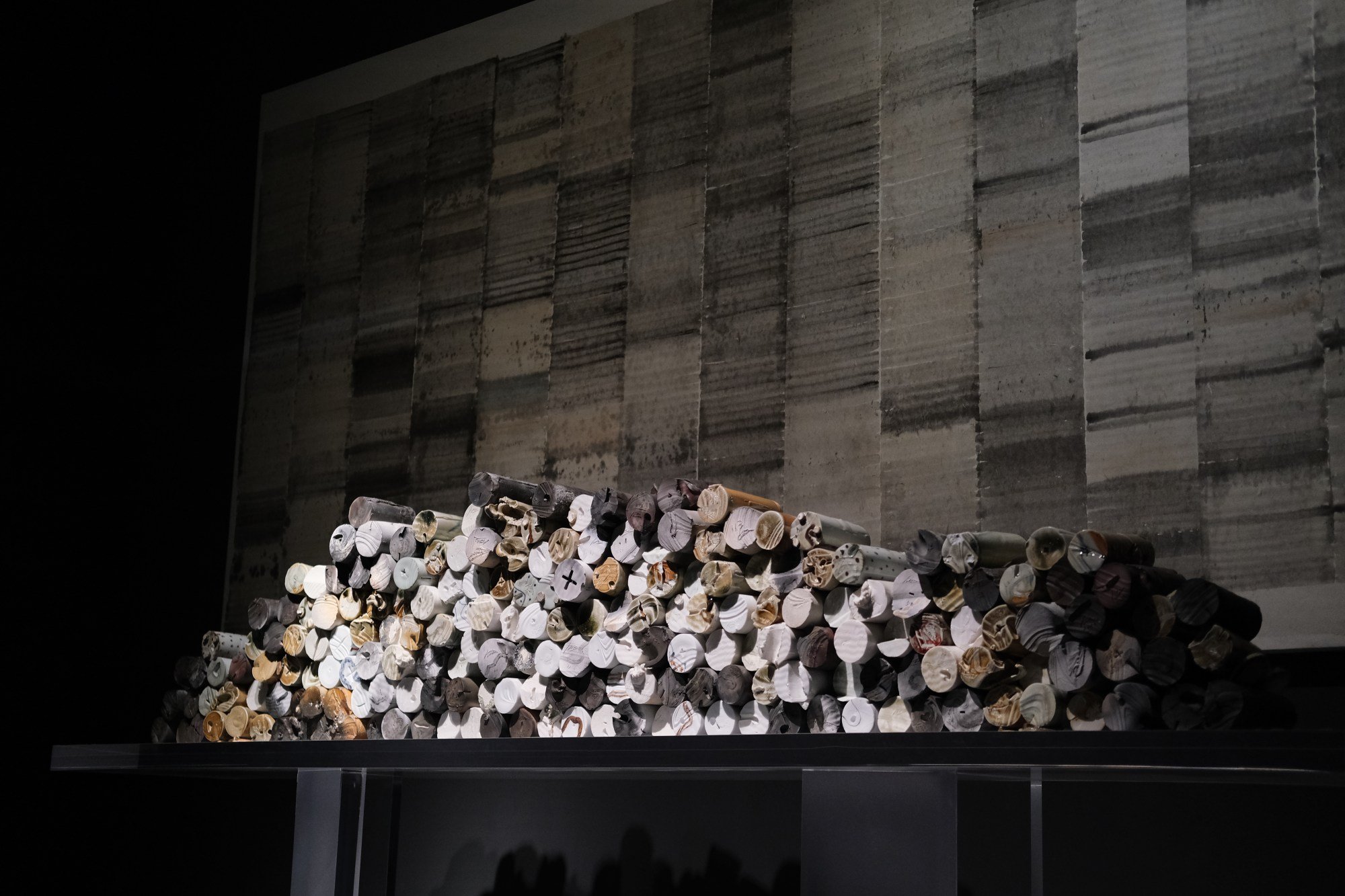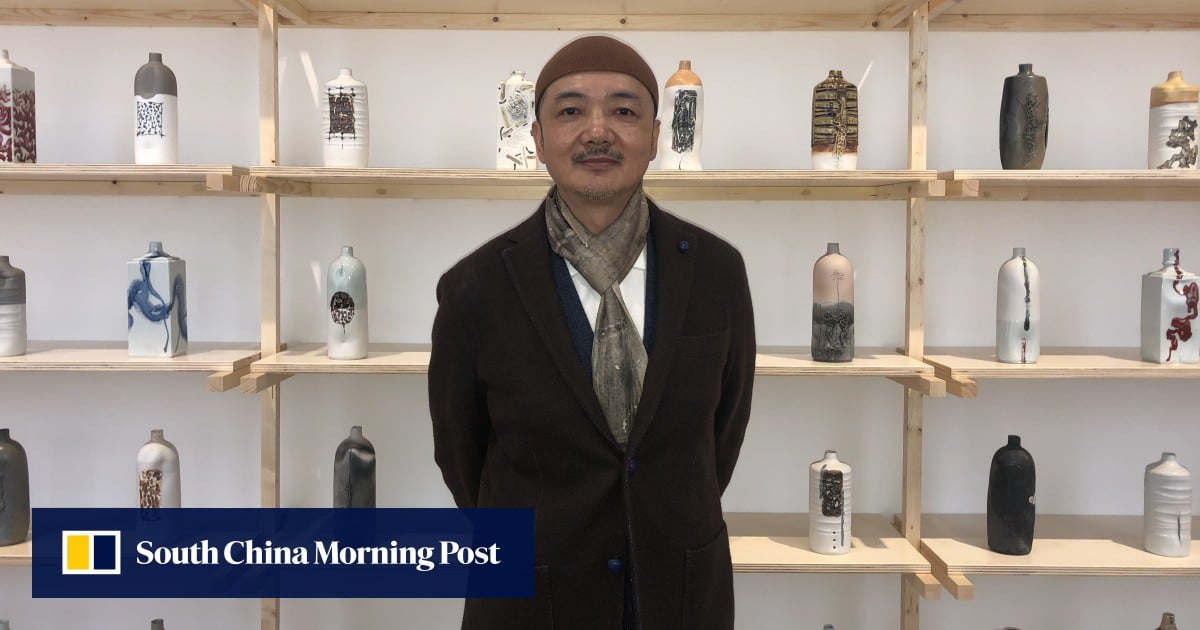Meanwhile, a video introduced Bai as someone embodying the essence of Zen, Taoism and Confucianism – a perfect package of Eastern mysticism.

There is indeed a strong sense of cultural lineage and historical references among the 80 pieces on show – mostly ceramics but with paintings, too.
For example, The Wall of Scrolls (2022) is made up of around 200 ceramic cylinders of the same dimension stacked together to form a low wall of varying heights. Fired using different methods, the “scrolls” made from a mixture of clay and paper pulp vary greatly in appearance: some look almost like charcoal or wet river rocks, others like unused rolls of xuan paper of the type commonly used for Chinese painting and calligraphy.
The work’s backdrop – a large, separate paper work of lines painted in ink and tea, called Book-like Mat Patterns – resembles a veritable fortress of books piled high, perhaps representing a culture thousands of years old that has settled and solidified, becoming the wall of scrolls in front of it.
“Scrolls are the most important form in Chinese art,” says Bai, wearing his signature beanie. “What I have made are not actual scrolls but a symbol of unique aspects of Chinese culture, which also includes a great deal of diversity.”
Scholar’s rocks are one of Bai’s favourite motifs – either as decoration or as stand-alone ceramic sculptures. His giant vases, often in classical shapes, include some decorated with painted scholar’s rocks, as well as a series featuring the traditional cobalt blue long used for Chinese blue-and-white wares.
The 100 cups neatly arranged on shelves near the exhibition entrance are all without handles, like the Chinese cups the confessed tea addict uses himself.
His series of lacquer paintings – dark scenes of shapeless chaos with titles such as A Suspended Dimension (2018) – comes from a love of the material’s uniqueness to Chinese culture, he says.
“I started making lacquer paintings in 2017. It is such a noble material and one that has been used as a protective and decorative material in China for thousands of years. It is incredibly hard. You can throw a hammer at it and it still won’t break. To me, it is the closest I can get to eternity,” he says.
Bai, whose name literally means white light, or white clarity, has spent many years considering his relationship with traditional culture.
Born in 1965 near Jingdezhen, the historic centre of porcelain production in China, in Jiangxi province, Bai grew up during the Cultural Revolution and served in the army after high school, before enrolling as a mature student in the Central Academy of Arts and Design, which was later absorbed by Tsinghua University, in 1999.
He started out as a painter and a mixed media artist, but later added ceramics to his practice because, as he describes it, learning to make ceramics was to learn how to be restrained.
“It is so hard. It takes so many years of practice to grapple with the technical demands and then you are still limited by so many things, like the fragility of the material and the fact that you must never let the wheel go too fast when throwing,” he says.
Once he had perfected his skills as a craftsman, he began to experiment beyond perfect forms.
“You always start out trying to grasp all the techniques but afterwards, you have to ask yourself what the perfect techniques are for. I still make usable cups and vases but in parallel to those, I make pieces that have no function and merely highlight the artistic quality of ceramics.”
Decades on, he continues to be fascinated by newly discovered facets of the timeless material, as he and a team of assistants experiment in his studios in Beijing, Jingdezhen and at the Shangyu Celadon Contemporary International Ceramic Art Center, in Zhejiang province, which he co-founded in 2015 with the local government. Shangyu, a district of the city of Shaoxing, was historically a site of kilns that produced China’s legendary celadon ware.
Bai keenly points out the different treatment received by a group of flat dishes, each with its own idiosyncratic style. A perfectly white kaolin dish with marks echoing his ink and tea paintings, suggestive of emerging, primeval forms, was fired at a regular temperature. Next to it is an ashen, nearly black dish that gives a “thud” rather than a “ping” when tapped.
On close inspection, the piece made from smoke-firing at 1,300 degrees Celsius (2,372 degrees Fahrenheit), an extremely high temperature for this method, is a rich visual feast of oxidised metals and marks left by remnants of shells and seaweed.
A cluster of giant vases – a series called “Lines of Water” – are evocative of a shimmering ocean, the layers of fine lines in cobalt blue making them examples of classical blue-and-white forms given a contemporary update.
Rows of small, unruly vases, each one a different mutation from a basic template, are all mini rule-breakers. Those with slits in the middle would not hold water, literally. Shown in a gallery known for its large selection of 20th-century avant-garde European art – including a number of Lucio Fontana’s slashed canvases that are hanging nearby – Bai’s cuts through his own historically informed pieces look more like violent repudiation of past conventions than merely paying obeisance to glorious heritage.
In another series, called “The Spigots”, the gashes in the ceramic models of rolled-up scrolls seem to denote a cultural system that is far from airtight. Indeed, the exhibition’s curator, Jean-Louis Andral, says he intends for the show to help break down categories such as East and West, and silos containing different media.
The director of the Picasso Museum in Antibes, France, and an expert on Picasso’s ceramics in particular, Andral says he finds similarities in Bai’s cross-media practice and his ability to straddle the traditional and the contemporary.
As a young man originally trained in socialist realism art, Bai went through a phase when he tried to present himself as a “world artist”.
“When I was young, I was really keen not to be labelled an ‘Oriental artist’. I was in my 20s. I wanted to become a world artist. But you can’t become something you are not. In my bones, I am from an Eastern culture. However, I feel I can have a fruitful dialogue with international audiences even though I have never studied or lived abroad,” he says.
He is aware of how much harder it has become for such dialogues to take place in today’s geopolitical context, despite frequent calls by various governments for “international cultural exchange”.
“China’s understanding of the West and the West’s understanding of China are both out of sync. The result is Orientalist and Occidentalist simplification of different cultures,” he says.
“A common misconception of Chinese art is that it is traditional, that it has no relevance with today’s world. But what I want to show people is that innovation and individuality are part of the Chinese tradition.”
Among the many visitors who attended the packed opening, one lady of Persian heritage peered at a teacup with blue markings. Turning around, she said with a note of surprise that the lines reminded her of the Persian script, inadvertently highlighting the Middle Eastern origin of cobalt-blue ceramics.
“Artists are pulled in different ways, by different cultures,” Bai says. “What I want to ask is, why polarise Chinese and the West, or with other traditions? They are not antagonistic, and we learn from each other in order to create and be innovative.”
“Bai Ming: At the Crossroads of Worlds”, supported by Hong Kong’s Kwai Fung Foundation, is showing at the National Gallery of Modern and Contemporary Art, Rome, until June 30.

